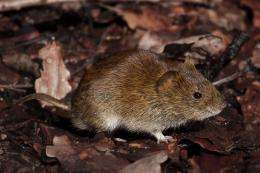Bank Vole sitting on the forest floor. Image: Evan James hymo/ Wikipedia.
(PhysOrg.com) -- While size may not matter when it comes to humans, a new study published in Behavioural Ecology and Sociobiology found that the width of the male bank vole’s penis plays a role in social dominance.
Male bank voles have a bone in their penis known as baculum. While these bones are not present in humans, they can be found in a variety of different mammal species. The function of this bone has not yet been determined, but this new study does show that when it comes to the bank vole, it plays an important role.
The new study, led by Dr. Jean-Francois Lemaitre from the University of Liverpool, looked at the male bank vole to determine what contributed to social dominance. They collected wild bank voles and studied their offspring.
They paired the young males up and exposed them to female nesting material. Scent mark patterns were then recorded and the males that left more scent marks were determined to be the dominant of the pair.
The next step was to then scan the baculum of all the males and evaluate the images. While many previous studies have focused on the penis length, the researchers discovered the real difference was in the width and that the dominant males have a much wider baculum than their subordinate male counterparts.
Lemaitre believes the possible explanation may be that female bank voles need physical stimulation in order to release eggs and that this wider baculum may provide this stimulation and result in a greater reproduction success rate.
He believes that this study may be the first step toward understanding the connection between genital structure and reproductive success.
More information: Genital morphology linked to social status in the bank vole (Myodes glareolus), Behavioural Ecology and Sociobiology, DOI:10.1007/s00265-011-1257-4
Abstract
Since genital morphology can influence the outcome of post-copulatory sexual selection, differences in the genitalia of dominant and subordinate males could be a factor contributing to the fertilisation advantage of dominant males under sperm competition. Here we investigate for the first time if penile morphology differs according to male social status in a promiscuous mammal, the bank vole (Myodes glareolus). In this species, dominant males typically achieve higher reproductive success than subordinates in post-copulatory sexual selection, and male genital morphology is complex, including both a baculum (os penis) and penile spines. Our results show that despite no difference in body size associated with male social status, baculum width is significantly larger in dominant male bank voles than in subordinates. We also found evidence of positive allometry and a relatively high coefficient of phenotypic variation in the baculum width of male bank voles, consistent with an influence of sexual selection. By contrast, baculum length and three measures of penile spinosity did not differ according to male social status or show evidence of positive allometry. We conclude that dominant male bank voles may benefit from an enlarged baculum under sperm competition and/or cryptic female choice and that differences in penile morphology according to male social status might be important but as yet largely unexplored source of variation in male reproductive success.
via BBC
© 2011 PhysOrg.com



















